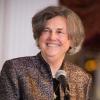
(Dreamstime/Andrea Obzerova)
The questions below are related to your reading and study on the question of women deacons. You may consult your notes regarding your personal examination of ancient liturgies, historical documents, epigraphical evidence (tombstones), frescos, mosaics, and early literary descriptions of ministry by women. Please do not use internet sources, including online general magazines and blogs.
Circle the correct answer for questions 1-20 and for the extra credit question. Write your essay in your blue book. T/F questions = 4 points each; extra credit question = 4 points; essay = 20 points. Your answer to the essay question must be at least 300 words. Please answer all questions in black or blue pen.
You have 45 minutes to complete this examination. Remember to put your name on all test materials.
True/False
1. Christian revelation defines the essential humanity of all men and women (all are created in the image and likeness of God). (T/F)
2. The early church included orders of virgins and widows as well as the order of deacons (male and female). (T/F)
3. Some women of the ancient church who provided diaconal service were referred to as deacons (or deacon women). (T/F)
4. Some women of the ancient church who provided diaconal service were referred to as deaconesses. (T/F)
5. Wives of male deacons were referred to as deaconesses. (T/F)
6. The women of the ancient church referred to as deacons or deaconesses and who provided diaconal service were ordained by their bishops inside the sanctuary, during liturgies. (T/F)
7. The ordaining bishops laid hands on the women they ordained as deacons. (T/F)
8. The rituals ordaining bishops used included an epiclesis, or invocation of the Holy Spirit. (T/F)
9. The rituals used by bishops for women deacons were equal to those used for men deacons. (T/F)
10. Some rituals used by bishops directed the bishop to place a stole around the neck of the ordained woman. (T/F)
11. While tasks and duties differed from place to place, the women deacons assisted at baptisms of other women. (T/F)
12. While tasks and duties differed from place to place, women deacons often visited ill women, brought them Eucharist, and anointed them. (T/F)
13. While tasks and duties differed from place to place, women deacons provided the ministry of charity to members of the Christian community. (T/F)
14. In various times and places, early women deacons assisted at the altar during liturgy. (T/F)
15. Popes and bishops eventually banned women's altar service because women were "unclean." (T/F)
16. Abbesses, the heads of women's abbeys and monasteries, were often ordained as deacons. (T/F)
Advertisement
17. The cursus honorum (course of honor) comprised the steps on the way to priesthood (tonsure, porter, lector, exorcist, acolyte, subdeacon, deacon). (T/F)
18. The development of the cursus honorum (course of honor) gradually eliminated the diaconate as a stand-alone ministry. (T/F)
19. In the West, because women were never in the cursus honorum, the practice of ordaining women to the diaconate died out in the 12th century; abbesses were no longer ordained, but were blessed or consecrated. (T/F)
20. Several Orthodox churches never completely abandoned the ordinations of women as deacons. (T/F)
Extra credit: The 1967 document of the Second Vatican Council, Musicam Sacram, states choirs that include women may not sing within the sanctuary. (T/F)
Essay: Given that history alone is not decisive, do you think the Catholic Church today can include women in the one order of deacon as it has been renewed following Vatican II? Do you think the Catholic Church should do so? Why? Why not?
Remember, you must include reference to the facts of revelation and history to support your argument regarding the sacramental ordination of women to the order of deacon.
Please return your answers to your bishop or patriarch.
[Phyllis Zagano is senior research associate-in-residence at Hofstra University in Hempstead, New York. She will speak Friday, Sept. 13, 2019, at the Bishop Keane Institute of Immaculate Conception Church in Hampton, Virginia. Her books include Women Deacons: Past, Present, Future, recently published in France and Canada as Des femmes diacres and in Portugal as Mulheres diáconos: Passado, presente, futuro. Study guides are available for free download at people.hofstra.edu/Phyllis_Zagano.]
Editor's note: We can send you an email alert every time Phyllis Zagano's column, Just Catholic, is posted. Click here to sign up for email alerts.







